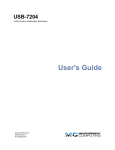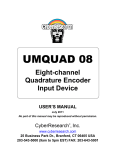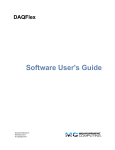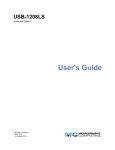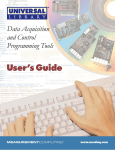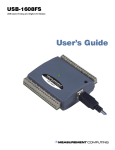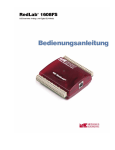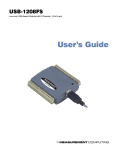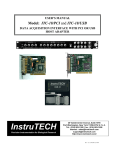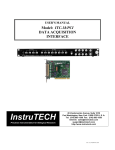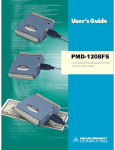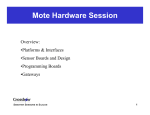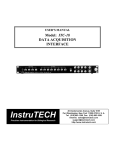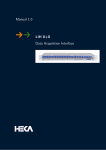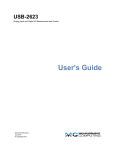Download USB-7202 User`s Guide - Measurement Computing
Transcript
USB-7202 Analog and Digital I/O User's Guide Document Revision 10 December 2014 © Copyright 2014 Your new Measurement Computing product comes with a fantastic extra — Management committed to your satisfaction! Thank you for choosing a Measurement Computing product—and congratulations! You own the finest, and you can now enjoy the protection of the most comprehensive warranties and unmatched phone tech support. It’s the embodiment of our mission: To provide data acquisition hardware and software that will save time and save money. Simple installations minimize the time between setting up your system and actually making measurements. We offer quick and simple access to outstanding live FREE technical support to help integrate MCC products into a DAQ system. Limited Lifetime Warranty: Most MCC products are covered by a limited lifetime warranty against defects in materials or workmanship for the life of the product, to the original purchaser, unless otherwise noted. Any products found to be defective in material or workmanship will be repaired, replaced with same or similar device, or refunded at MCC’s discretion. For specific information, please refer to the terms and conditions of sale. Harsh Environment Program: Any Measurement Computing product that is damaged due to misuse, or any reason, may be eligible for replacement with the same or similar device for 50% of the current list price. I/O boards face some harsh environments, some harsher than the boards are designed to withstand. Contact MCC to determine your product’s eligibility for this program. 30 Day Money-Back Guarantee: Any Measurement Computing Corporation product may be returned within 30 days of purchase for a full refund of the price paid for the product being returned. If you are not satisfied, or chose the wrong product by mistake, you do not have to keep it. These warranties are in lieu of all other warranties, expressed or implied, including any implied warranty of merchantability or fitness for a particular application. The remedies provided herein are the buyer’s sole and exclusive remedies. Neither Measurement Computing Corporation, nor its employees shall be liable for any direct or indirect, special, incidental or consequential damage arising from the use of its products, even if Measurement Computing Corporation has been notified in advance of the possibility of such damages. Trademark and Copyright Information Measurement Computing Corporation, InstaCal, Universal Library, and the Measurement Computing logo are either trademarks or registered trademarks of Measurement Computing Corporation. Refer to the Copyrights & Trademarks section on mccdaq.com/legal for more information about Measurement Computing trademarks. Other product and company names mentioned herein are trademarks or trade names of their respective companies. © 2014 Measurement Computing Corporation. All rights reserved. No part of this publication may be reproduced, stored in a retrieval system, or transmitted, in any form by any means, electronic, mechanical, by photocopying, recording, or otherwise without the prior written permission of Measurement Computing Corporation. Notice Measurement Computing Corporation does not authorize any Measurement Computing Corporation product for use in life support systems and/or devices without prior written consent from Measurement Computing Corporation. Life support devices/systems are devices or systems that, a) are intended for surgical implantation into the body, or b) support or sustain life and whose failure to perform can be reasonably expected to result in injury. Measurement Computing Corporation products are not designed with the components required, and are not subject to the testing required to ensure a level of reliability suitable for the treatment and diagnosis of people. HM USB-7202 Table of Contents Preface About this User's Guide ....................................................................................................................... 5 Conventions ........................................................................................................................................................ 5 Where to find more information ......................................................................................................................... 5 Chapter 1 Introducing the USB-7202 .................................................................................................................... 6 Functional block diagram ................................................................................................................................... 7 Chapter 2 Installing the USB-7202 ........................................................................................................................ 8 Unpacking........................................................................................................................................................... 8 Installing the software ........................................................................................................................................ 8 Installing the hardware ....................................................................................................................................... 8 Calibrating the hardware..................................................................................................................................... 9 Factory calibration ............................................................................................................................................................ 9 Field calibration ................................................................................................................................................................ 9 Chapter 3 Functional Details ............................................................................................................................... 10 Analog input acquisition modes ....................................................................................................................... 10 Software paced .................................................................................................................................................................10 Hardware paced ...............................................................................................................................................................10 BURSTIO ........................................................................................................................................................................10 Board components ............................................................................................................................................ 11 USB connector .................................................................................................................................................................11 OEM connector ................................................................................................................................................................11 Trigger/Sync connector....................................................................................................................................................12 LED indicators .................................................................................................................................................................12 Screw terminals................................................................................................................................................................13 Signal connections ............................................................................................................................................ 13 Analog input ....................................................................................................................................................................13 Digital I/O ........................................................................................................................................................................13 SYNC I/O ........................................................................................................................................................................14 Trigger input ....................................................................................................................................................................14 Counter input ...................................................................................................................................................................14 Power output ....................................................................................................................................................................14 Ground .............................................................................................................................................................................14 Accuracy ........................................................................................................................................................... 15 Synchronized operations................................................................................................................................... 17 Mechanical drawing ......................................................................................................................................... 18 Chapter 4 Specifications ...................................................................................................................................... 19 Analog input ..................................................................................................................................................... 19 Digital input/output........................................................................................................................................... 20 External trigger ................................................................................................................................................. 20 External clock input/output............................................................................................................................... 21 Counter ............................................................................................................................................................. 21 Memory ............................................................................................................................................................ 21 Microcontroller ................................................................................................................................................. 22 Indicator LEDs ................................................................................................................................................. 22 Power ................................................................................................................................................................ 22 3 USB-7202 User's Guide General ............................................................................................................................................................. 23 Environmental .................................................................................................................................................. 23 Mechanical ....................................................................................................................................................... 23 Screw terminal connector and pinout ............................................................................................................... 23 OEM connector and pinout (P4) ....................................................................................................................... 25 Trigger/Sync connector and pinout (P5) ........................................................................................................... 25 4 Preface About this User's Guide This document describes the Measurement Computing USB-7202 data acquisition device and lists device specifications. Conventions For more information Text presented in a box signifies additional information related to the subject matter. Caution! Shaded caution statements present information to help you avoid injuring yourself and others, damaging your hardware, or losing your data. bold text Bold text is used for the names of objects on a screen, such as buttons, text boxes, and check boxes. italic text Italic text is used for the names of manuals and help topic titles, and to emphasize a word or phrase. Where to find more information Additional information about USB-7202 hardware is available on our website at www.mccdaq.com. You can also contact Measurement Computing Corporation with specific questions. Knowledgebase: kb.mccdaq.com Tech support form: www.mccdaq.com/support/support_form.aspx Email: [email protected] Phone: 508-946-5100 and follow the instructions for reaching Tech Support For international customers, contact your local distributor. Refer to the International Distributors section on our website at www.mccdaq.com/International. 5 Chapter 1 Introducing the USB-7202 The USB-7202 is a USB 2.0 full-speed device that provides the following features: Eight channels of 16-bit analog input o 100 kS/s max total throughput (200 kS/s with BURSTIO enabled), 50 kS/s on any one channel o Simultaneous sampling (1 A/D converter per input) o Independently configurable input ranges Eight individually configurable digital I/O channels 32-bit event counter Digital trigger input Bidirectional SYNC pin for external clocking and synchronization with another board USB/104 form factor Stackable 3.55" x 3.75" board dimensions The USB-7202 device is compatible with both USB 1.1 and USB 2.0 ports. The speed of the device may be limited when using a USB 1.1 port due to the difference in transfer rates on the USB 1.1 versions of the protocol (low-speed and full-speed). The USB-7202 is powered by the +5 volt USB supply from your computer; no external power is required. The device is compatible with both USB 1.1 and USB 2.0 ports. A USB cable is shipped with the device. Caution! There are no product safety, electromagnetic compatibility (EMC), or CE marking compliance claims made for the USB-7202. The USB-7202 is intended for use as a component of a larger system. MCC can help developers meet their compliance requirements. The end product supplier, however, is responsible for conforming to any and all compliance requirements. 6 USB-7202 User's Guide Introducing the USB-7202 Functional block diagram USB-7202 functions are illustrated in the block diagram shown here. Figure 1. Functional block diagram 7 Chapter 2 Installing the USB-7202 Unpacking As with any electronic device, you should take care while handling to avoid damage from static electricity. Before removing the device from its packaging, ground yourself using a wrist strap or by simply touching the computer chassis or other grounded object to eliminate any stored static charge. Contact us immediately if any components are missing or damaged. Installing the software Refer to the MCC DAQ Quick Start for instructions on installing the software on the MCC DAQ CD. Refer to the device product page on the Measurement Computing website for information about the included and optional software supported by the USB-7202. Install the software before you install your device The driver needed to run the USB-7202 is installed with the software. Therefore, you need to install the software package you plan to use before you install the hardware. Installing the hardware There are two ways to connect the USB-7202 to your system: Connect a USB cable from the USB connector to either a USB port on the computer or to an external USB hub connected to the computer. No external power is required. or Pin 1 3 5 7 9 Use a 2.54 mm (0.1 in.) box header to connect with the OEM connector. The connector pinout is shown here: Signal Name N/C N/C N/C (do not connect anything to this pin) N/C (do not connect anything to this pin) N/C (do not connect anything to this pin) Pin 2 4 6 8 10 Signal Name VBUS D– D+ GND SHIELD When you connect the USB-7202 for the first time, a Found New Hardware message opens as the device is detected. The installation is complete when the message closes. After the USB-7202 is installed, the Power LED remains on to indicate that communication is established between the USB-7202 and your computer. Caution! Do not disconnect any device from the USB bus while the computer is communicating with the USB-7202, or you may lose data and/or your ability to communicate with the USB-7202. If the Power LED turns off If the Power LED is on but then turns off, the computer has lost communication with the USB-7202. To restore communication, disconnect the USB cable from the computer, and then reconnect it. This should restore communication, and the Power LED should turn on. 8 USB-7202 User's Guide Installing the USB-7202 Calibrating the hardware Factory calibration The Measurement Computing Manufacturing Test department performs the initial factory calibration. Contact Measurement Computing for details about how to return your device and have it calibrated to the factory specifications. Field calibration The USB-7202 supports field calibration. Calibrate the device using InstaCal whenever the ambient temperature changes by more than ±10 °C from the last calibration. 9 Chapter 3 Functional Details Analog input acquisition modes The USB-7202 can acquire analog input data in three different modes – software paced, hardware paced, or BURSTIO. Software paced You can acquire one analog sample at a time in software paced mode. You initiate the A/D conversion by calling a software command. The analog value is converted to digital data and returned to the computer. You can repeat this procedure for each channel desired until you have the total number of samples that you want from each channel. The maximum throughput sample rate in software paced mode is about 250 S/s, but may vary depending on your system. You may receive OVERRUN errors at higher rates on some platforms. Using the BURSTIO mode should resolve these problems. Hardware paced You can acquire data from up to eight channels simultaneously in hardware paced mode. The analog data is continuously acquired and converted to digital values until you stop the scan. Data is transferred in blocks of up to 32 samples from the USB-7202 to the memory buffer on your computer. The maximum sampling rate is an aggregate rate, where the total sample rate for all channels is 100 kS/s divided by the number of channels, with a maximum rate of 50 kS/s for any channel. Using this equation, you can acquire data with the USB-7202 from one channel at 50 kS/s, two channels at 50 kS/s each, four channels at 25 kS/s each, and so on, up to eight channels at 12.5 kS/s each. You can start a hardware paced scan with either a software command or with an external hardware trigger event. BURSTIO When using BURSTIO, the USB-7202 can acquire data using the full capacity of its 32 kilosample FIFO. The acquired data is then read from the FIFO and transferred to a user memory buffer on the computer. You can initiate a single acquisition sequence for any number of input channels with either a software command or with an external hardware trigger. When BURSTIO is enabled, scans are limited to the depth of the onboard memory, as the data is acquired at a rate faster than it can be transferred to the computer. The maximum sampling rate is an aggregate rate, where the total acquisition rate for all channels is 200 kS/s divided by the number of channels. The maximum rate for each channel is 50 kS/s. The maximum rate that you can acquire data using BURSTIO is 50 kS/s per channel for one, two, or four channels, and 25 kS/s per channel for eight channels. 10 USB-7202 User's Guide Functional Details Board components The USB-7202 components are shown in Figure 2. 1 2 3 Trigger/Sync connector Pins 1-20 Trigger jumper (P6) Power LED (top) and Status LED (bottom) 4 5 6 USB connector Pins 1-20 Pull-up/down jumper JP1 OEM connector 7 8 9 Pins 21-40 Trigger jumper (P7) Sync jumper (P6) Figure 2. Board components USB connector The USB connector provides +5 V power and communication. The voltage supplied through the USB connector is system-dependent, and may be less than 5 V. No external power supply is required. This connector operates in parallel with the OEM connector — do not connect to both the USB connector and the OEM connector. OEM connector The OEM connector operates in parallel with the USB connector — do not connect to both the USB connector and the OEM connector. The OEM connector is a 0.1" box header. Pins 2, 4, 6, 8, and 10 provide a USB connection, as listed in the connector pinout below: OEM connector pinout Pin 1 3 5 7 9 Signal Name N/C N/C N/C (do not connect anything to this pin) N/C (do not connect anything to this pin) N/C (do not connect anything to this pin) Pin 2 4 6 8 10 11 Signal Name VBUS DD+ GND SHIELD USB-7202 User's Guide Functional Details Modifications are required in order to use the OEM connector We recommend that you return the device to the factory for this modification. Should you have the capabilities to perform the modifications, the following change is required: in order to create a USB connection via the OEM connector, locations R30and R36 must be populated. We recommend that you populate with 0603 size 0 Ω resistors or provide solder bridges to close the gaps. Trigger/Sync connector The Trigger/Sync connector provides two signals — SYNC and TRIG_IN. These signals are also available on the screw terminal (refer to Trigger input on page 14 for details about these signals). Trigger/Sync connector pinout Pin 1 3 5 7 9 Signal Name TRIG_IN N/C SYNC N/C N/C Pin Signal Name 2 GND 4 GND 6 GND 8 GND 10 N/CD Use a 0.1" box header when making connections to the Trigger/Sync connector. The Trigger/Sync connector internally connects its SYNC and TRIG_IN pins to the screw terminal via jumpers P6 and P7. Figure 3. Jumper P6 and P7 schematic Sync jumper (P6) The Sync jumper internally connects the SYNC pin on the Trigger/Sync connector to the SYNC pin on the screw terminal. Remove this jumper on boards that will not send/receive the SYNC signal through the SYNC/TRIG connector. Refer to Figure 2 on page 11 for the location of this jumper. Trigger jumper (P7) The Trigger jumper internally connects the TRIG_IN pin on the Trigger/Sync connector to the TRIG_IN pin on the screw terminal. Remove this jumper on boards that will not send/receive the TRIG signal through the SYNC/TRIG connector. Refer to Figure 2 on page 11 for the location of this jumper. LED indicators The USB-7202 has LEDs for power and communication status. See Figure 2 on page 11 for the location of each LED. LED type Indication Power Status Steady green: The device microcontroller is connected to a computer or external USB hub. Blinking green: data is being transferred over the USB bus. 12 USB-7202 User's Guide Functional Details Screw terminals Screw terminal connections in shown in Figure 4. Figure 4. Screw terminal pinout Use 16 AWG to 30 AWG when making screw terminal connections. Signal connections Analog input You can connect up to eight analog input connections to screw terminals CH0 IN through CH7 IN. Connect unused analog input terminals to ground terminals during operation. All AI channels are configured for single-ended input mode. The input voltage ranges are ±10 V, ±5 V, ±2.0 V, ±1.0 V. Each analog signal is referenced to signal ground (AGND), and requires two wires: The wire carrying the signal to be measured connects to CH# IN. The second wire connects to AGND. Digital I/O You can connect up to eight digital I/O lines to screw terminals DIO0 to DIO7. Each digital bit is configurable as either input or output. When configured for input, the digital I/O terminals can be used to detect the state of any TTL-level input. Pull-up/down configuration The digital pins are configurable via jumper JP1 for pull-up to USB +5 V (HI) or pull-down to ground (LO). On power up and reset the DIO pins are driven high. Figure 5. Jumper JP1 configuration 13 USB-7202 User's Guide Functional Details For more information on signal connections For general information regarding digital signal connections and digital I/O techniques, refer to the Guide to DAQ Signal Connections (available on our website at www.mccdaq.com/signals/signals.pdf). SYNC I/O The SYNC connection is a bidirectional I/O signal that can be configured as an input (default) or an output. Configure as an external clock input to pace the A/D conversions from an external source. The SYNC terminal supports TTL-level input signals of up to 50 kHz. Configure as an output to pace conversions on a second USB-7202. The SYNC pin on the screw terminal is internally connected to the SYNC pin on the Trigger/Sync connector (see page 12). Trigger input Use the digital trigger input (TRIG_IN) to start an acquisition when a rising or falling edge is detected on the signal. This pin is internally connected to the TRIG_IN pin on the Trigger/Sync connector (see page 12). Counter input The CTR connection is a TTL-level input to a 32-bit event counter. The internal counter increments when the TTL level transitions from low to high. The counter can count frequencies of up to 1 MHz. Power output The +5VUSER connection is a 5 volt output that is supplied by the host computer. Caution! Do not connect to an external power supply to this terminal or you may damage the USB-7202 and possibly the computer. The maximum total output current that can be drawn from all USB-7202 connections (power, analog, and digital outputs) is 500 mA. This maximum applies to most personal computers and self-powered USB hubs. Bus-powered hubs and notebook computers may limit the maximum available output current to 100 mA. The USB-7202 alone draws 150 mA of current from the USB +5 V supply. Once you start running applications with the USB-7202, each DIO bit can draw up to 2.5 mA. The maximum amount of +5 V current available for experimental use, over and above that required by the USB-7202, is the difference between the total current requirement of the USB-7202 (based on the application) and the allowed current draw of the computer platform (500 mA for desktop computers and self-powered hubs). It shall not exceed 375 mA, based on the Slo-Blo Fuse current rating connected to the +5V terminal. With all outputs at their maximum output current, you can calculate the total current requirement of the USB7202 USB +5 V as follows: (USB-7202 @ 150 mA) + (8 DIO @ 2.5 mA ea) = 170 mA For an application running on a computer or powered hub, the maximum available excess current is 500 mA − 170 mA = 330 mA. This number is the total maximum available current at the +5VUSER screw terminal. Measurement Computing highly recommends that you figure in a safety factor of 20% below this maximum current loading for your applications. A conservative, safe user maximum in this case would be in the 250 mA to 300 mA range. Since some laptop computers running on battery power only allow up to 100 mA, the USB-7202 may be above that allowed by the computer. In this case, you must either purchase a self-powered hub or operate the laptop computer from an external power adapter. Ground The analog ground (AGND) terminals provide a common ground for all analog channels. The digital ground (GND) terminals provide a common ground for the digital, trigger, counter, and sync channels and the power terminal. 14 USB-7202 User's Guide Functional Details Accuracy The overall accuracy of any instrument is limited by the error components within the system. Quite often, resolution is incorrectly used to quantify the performance of a measurement product. While "16-bits" or "1 part in 65,536" does indicate what can be resolved, it provides little insight into the quality, or accuracy, of an absolute measurement. Accuracy specifications describe the actual measurement that can be relied upon with a USB-7202. There are three types of errors which affect the accuracy of a measurement system: offset gain nonlinearity The primary error sources in the USB-7202 are offset and gain. Nonlinearity is small in the USB-7202, and is not significant as an error source with respect to offset and gain. Figure 6 shows an ideal, error-free, USB-7202 transfer function. The typical calibrated accuracy of the USB7202 is range-dependent, as explained in the Specifications chapter on page 19. We use a ±10 V range as an example of what you can expect when performing a measurement in this range. The accuracy plots in Figure 6 are drawn for clarity and are not drawn to scale. Figure 6. Ideal ADC transfer function The USB-7202 offset error is measured at mid-scale. Ideally, a zero volt input should produce an output code of 32,768. Any deviation from this is an offset error. Figure 7 shows the USB-7202 transfer function with an offset error. The typical offset error specification for the USB-7202 on the ±10 V range is ±1.66 mV. Offset error affects all codes equally by shifting the entire transfer function up or down along the input voltage axis. 15 USB-7202 User's Guide Functional Details The accuracy plots in Figure 7 are drawn for clarity and are not drawn to scale. Figure 7. ADC transfer function with offset error Gain error is a change in the slope of the transfer function from the ideal, and is typically expressed as a percentage of full-scale. Figure 8 shows the USB-7202 transfer function with gain error. Gain error is easily converted to voltage by multiplying the full-scale input (±10 V) by the error. The accuracy plots in Figure 8 are drawn for clarity and are not drawn to scale. Figure 8. ADC Transfer function with gain error For example, the USB-7202 exhibits a typical calibrated gain error of ±0.04% on all ranges. For the ±10 V range, this would yield 10 V × ±0.0002 = ±4 mV. This means that at full scale, neglecting the effect of offset for the moment, the measurement would be within 4 mV of the actual value. Note that gain error is expressed as a ratio. Values near ±FS (±10 V) are more affected from an absolute voltage standpoint than are values near mid-scale, which see little or no voltage error. Combining these two error sources in Figure 9, we have a plot of the error band of the USB-7202 at ±full scale (±10 V). This plot is a graphical version of the typical accuracy specification of the product. 16 USB-7202 User's Guide Functional Details The accuracy plots in Figure 9 are drawn for clarity and are not drawn to scale. Figure 9. Error band plot Synchronized operations You can connect the SYNC pin of two USB-7202 devices together in a master/slave configuration and acquire data from the analog inputs of both devices using one clock. When the SYNC pin is configured as an output, the internal A/D pacer clock signal is sent to the screw terminal. If jumper P6 is installed, you can output the clock to the SYNC pin of a second USB-7202 configured for A/D pacer input. The SYNC pin is available on both the screw terminal connector and on the Trigger/SYNC connector (when jumper P6 is installed). Refer to page 14 for more information about the SYNC pin. 17 USB-7202 User's Guide Functional Details Mechanical drawing Figure 10. Circuit board dimensions 18 Chapter 4 Specifications All specifications are subject to change without notice. Typical for 25 °C unless otherwise specified. Specifications in italic text are guaranteed by design. Analog input Table 1. Analog input specifications Parameter Conditions A/D converter type Number of channels Input configuration Sampling method Absolute maximum input voltage Input impedance Input ranges Sampling rate Throughput Specification CHx IN to GND Software-selectable Scan to system memory BURSTIO scan to 32 k sample FIFO Software paced Scan to system memory (Note 1) BURSTIO scan to 32 k Sample FIFO Resolution No missing codes Crosstalk Trigger source Calibration Signal DC–25 kHz Software-selectable 16-bit successive approximation type 8 single-ended Individual A/D per channel Simultaneous ±15 V max 100 MΩ min ±10 V, ±5 V, ±2 V, ±1 V 0.6 S/s to 50 kS/s, software-selectable 20 S/s to 50 kS/s, software-selectable 500 S/s all channels, system-dependent (100 kS/s) / (# of channels); maximum of 50 kS/s for any channel (200 kS/s) / (# of channels), maximum of 50 kS/s for any channel 16 bits 15 bits –80 dB External digital: TRIG_IN Cal factors stored in firmware. Cal factors must be applied to data via application software. Note 1: Maximum throughput scanning to system memory is machine dependent. Table 2. Calibrated absolute accuracy Range Accuracy (mV) ±10 V ±5 V ±2 V ±1 V 5.66 2.98 1.31 0.68 Table 3. Accuracy components - All values are (±) Range % of Reading Gain error at FS (mV) Offset (mV) ±10 V ±5 V ±2 V ±1 V 0.04 0.04 0.04 0.04 4.00 2.00 0.80 0.40 1.66 0.98 0.51 0.28 19 USB-7202 User's Guide Specifications Table 4 summarizes the noise performance for the USB-7202. Noise distribution is determined by gathering 50 K samples with inputs tied to ground at the user connector. Samples are gathered at the maximum specified sampling rate of 50 kS/s. Table 4. Noise performance Range Typical counts LSBrms ±10 V ±5 V ±2 V ±1 V 10 10 11 14 1.52 1.52 1.67 2.12 Digital input/output Table 5. Digital I/O specifications Parameter Specification Digital type Number of I/O Configuration Pull-up/pull-down configuration Input high voltage Input low voltage Output high voltage (IOH = –2.5 mA) Output low voltage (IOL = 2.5 mA) Power on and reset state CMOS 8 (DIO0 through DIO7) Independently configured for input or output All pins configurable via jumper (JP1) to Vs or ground via 47 kΩ resistors. 2.0 V min, 5.5 V absolute max 0.8 V max, –0.5 V absolute min 3.8 V min 0.7 V max Input External trigger Table 6. External trigger specifications Parameter Conditions Specification Trigger source (Note 2) Trigger mode External digital Software-selectable TRIG_IN Edge sensitive: user configurable for CMOS compatible rising or falling edge. 10 µs max 1µs min 4.0 V min, 5.5 V absolute max 1.0 V max, –0.5 V absolute min ±1.0µA Trigger latency Trigger pulse width Input high voltage Input low voltage Input leakage current Note 2: TRIG_IN is a Schmitt trigger input protected with a 1.5K Ohm series resistor. 20 USB-7202 User's Guide Specifications External clock input/output Table 7. External clock I/O specifications Parameter Pin name Pin type Software-selectable direction Input clock rate Clock pulse width Input leakage current Input high voltage Input low voltage Output high voltage (Note 3) Output low voltage (Note 3) Conditions Specification SYNC Bidirectional Outputs internal A/D pacer clock. Receives A/D pacer clock from external source. 50 kHz, max 1µs min 5µs min ±1.0µA 4.0 V min, 5.5 V absolute max 1.0 V max, –0.5 V absolute min 3.3 V min 3.8 V min 1.1 V max 0.6 V max Output Input Input Output IOH = –2.5 mA No load IOL = 2.5 mA No load Note 3: SYNC is a Schmitt trigger input and is over-current protected with a 1.5 kΩ series resistor. Counter Table 8. Counter specifications Parameter Specification Pin name (Note 4) Counter type Number of channels Input type Input source Resolution Schmidt trigger hysteresis Input leakage current Input frequency High pulse width Low pulse width Input high voltage Input low voltage CTR Event counter 1 TTL, rising edge triggered CTR screw terminal 32 bits 20 mV to 100 mV ±1µA 1 MHz max 500 ns min 500 ns min 4.0 V min, 5.5 V absolute max 1.0 V max, –0.5 V absolute min Note 4: CTR is a Schmitt trigger input protected with a 1.5 kΩ series resistor. Memory Table 9. Memory specifications Parameter Specification Data FIFO EEPROM EEPROM configuration 32,768 samples, 65,536 bytes 1,024 bytes Address range Access Description 0x000-0x1FF 0x200-0x3FF Reserved Read/write 512 bytes system and Cal data 512 bytes user area 21 USB-7202 User's Guide Specifications Microcontroller Table 10. Microcontroller specifications Parameter Specification Type Program memory Data memory High performance 8-bit RISC microcontroller 32,768 words 3,936 bytes Indicator LEDs Table 11. Indicator LED specifications Parameter Specification Power LED (top) Status LED OEM power Indicates that the device’s microcontroller has power and is configured. Blinks to indicate USB communications. OEM Connector; LED sink current up to 5 mA per LED @ 5 Vmax Power Table 12. Power specifications Parameter Conditions Specification Supply current +5VUSER power available (Note 6) USB enumeration Continuous mode Connected to self-powered hub Connected to externally-powered root port hub < 100 mA 150 mA (Note 5) 4.0 V min, 5.25 V max Output current (Note 7) Fuse F1, (F4 spare) Fuse F2, (F3 spare) 350 mA max 0452.500 - Littelfuse 0.5A NANO2® Slo-Blo® Subminiature Surface Mount Fuse 0452.375 - Littelfuse 0.375A NANO2® Slo-Blo® Subminiature Surface Mount Fuse Note 5: This is the total current requirement for the USB-7202, which includes up to 10 mA for the status LED. Note 6: "Self-powered hub" refers to a USB hub with an external power supply. Self-powered hubs allow a connected USB device to draw up to 500 mA. "Root port hubs" reside in the computer USB host Controller. The USB port(s) on your computer are root port hubs. All externally-powered root port hubs (desktop computers) provide up to 500 mA of current for a USB device. Battery-powered root port hubs provide 100 mA or 500 mA, depending upon the manufacturer. A laptop computer that is not connected to an external power adapter is an example of a battery-powered root port hub. If your laptop computer is constrained to the 100 mA maximum, you need to purchase a self-powered hub. Note 7: This is the total amount of current that can be sourced from the +5VUSER and digital outputs. Fuse for +5V terminal is rated at 375 mA. 22 USB-7202 User's Guide Specifications General Table 13. General specifications Parameter Specification Device type Device compatibility DEFAULTS for programmable options and "DEV:RESET/DEFAULT" message USB 2.0 (full-speed) USB 1.1, USB 2.0 AInScan Low channel = 0 High channel = 0 Samples = 1000 Rate = 1000 Range = ±10 V Pacer = Disabled (Slave) Transfer mode = BlockIO Trigger = Disabled Status = Idle AITrig Trigger polarity = Rising CTR Value = 0 Environmental Table 14. Environmental specifications Parameter Specification Operating temperature range Storage temperature range Humidity 0 °C to 70 °C –40 °C to 70 °C 0% to 90% non-condensing Mechanical Table 15. Mechanical specifications Parameter Specification Dimensions (L × W × H) 90.17 × 95.25 × 12.70 mm (3.55 × 3.75 × 0.5 in.) 111.76 mm (4.40 in.) length with detachable screw terminals connected 3 m (9.84 ft) max 3 m (9.84 ft) max USB cable length User connection length Screw terminal connector and pinout Table 16. Connector specifications Parameter Specification Connector type Wire gauge range Detachable screw terminal 16 AWG to 30 AWG 23 USB-7202 User's Guide Specifications Table 17. Connector pinout Pin 1 2 3 4 5 6 7 8 9 10 11 12 13 14 15 16 17 18 19 20 Signal Name CH0 IN AGND CH1 IN AGND CH2 IN AGND CH3 IN AGND CH4 IN AGND CH5 IN AGND CH6 IN AGND CH7 IN AGND N/C (no connect) AGND AGND AGND Pin 21 22 23 24 25 26 27 28 29 30 31 32 33 34 35 36 37 38 39 40 24 Signal Name DIO0 GND DIO1 GND DIO2 GND DIO3 GND DIO4 GND DIO5 GND DIO6 GND DIO7 SYNC TRIG_IN CTR +5VUSER GND USB-7202 User's Guide Specifications OEM connector and pinout (P4) Table 18. OEM connector specifications Parameter Specification Connector type 10 position 2.54 mm (0.1 in.) box header Table 19. OEM connector pinout Pin 1 3 5 7 9 Signal Name N/C N/C N/C (do not connect anything to this pin) N/C (do not connect anything to this pin) N/C (do not connect anything to this pin) Pin 2 4 6 8 10 Signal Name VBUS (fuse protected) D– D+ GND SHIELD Trigger/Sync connector and pinout (P5) Table 20. Trigger/Sync connector specifications Parameter Specification Connector type 10 position 2.54 mm (0.1 in.) box header Table 21. Trigger/Sync connector pinout Pin 1 3 5 7 9 Signal Name TRIG_IN N/C SYNC N/C N/C Pin 2 4 6 8 10 25 Signal Name GND GND GND GND N/C Measurement Computing Corporation 10 Commerce Way Suite 1008 Norton, Massachusetts 02766 (508) 946-5100 Fax: (508) 946-9500 E-mail: [email protected] www.mccdaq.com


























